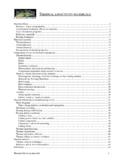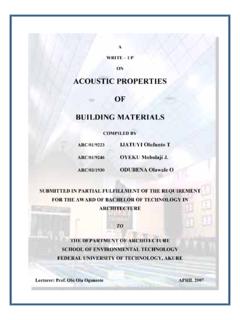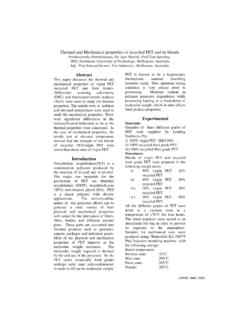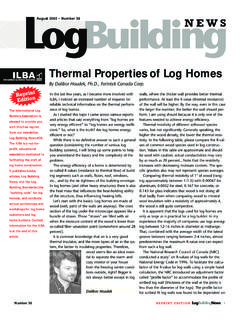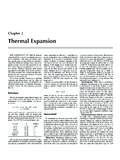Transcription of Thermal conductivity accumulation in amorphous silica …
1 PHYSICAL REVIEW B 89, 144303 (2014). Thermal conductivity accumulation in amorphous silica and amorphous silicon Jason M. Larkin and Alan J. H. McGaughey*. Department of Mechanical Engineering, Carnegie Mellon University, Pittsburgh, Pennsylvania 15213, USA. (Received 22 August 2013; revised manuscript received 25 March 2014; published 14 April 2014). We predict the properties of the propagating and nonpropagating vibrational modes in amorphous silica (a-SiO2 ) and amorphous silicon (a-Si) and, from them, Thermal conductivity accumulation functions. The calculations are performed using molecular dynamics simulations, lattice dynamics calculations, and theoretical models. For a-SiO2 , the propagating modes contribute negligibly to Thermal conductivity (6%), in agreement with the Thermal conductivity accumulation measured by Regner et al.
2 [Nat. Commun. 4, 1640 (2013)]. For a-Si, propagating modes with mean-free paths up to 1 m contribute 40% of the total Thermal conductivity . The predicted contribution to Thermal conductivity from nonpropagating modes and the total Thermal conductivity for a-Si are in agreement with the measurements of Regner et al. The accumulation in the measurements, however, takes place over a narrower band of mean-free paths (100 nm 1 m) than that predicted (10 nm 1 m). DOI: PACS number(s): +a, , , I. INTRODUCTION Traditionally, empirical expressions and simple models have been the only means to estimate MFPs in amorphous materi- The vibrational modes in disordered solids ( , alloys, als [12 14,22], while the Allen-Feldman (AF) theory can be amorphous materials) can be classified as propagons (prop- used to model the nonpropagating modes [1,4].)
3 Agating and delocalized, , phononlike), diffusons (non- Predicting the vibrational MFPs in an amorphous solid propagating and delocalized), and locons (nonpropagating and requires the group velocities and lifetimes of the low-frequency localized) [1,2]. Diffusons contribute to Thermal conductivity propagating modes [4 8,12,13,15,18,23,24]. It is typically by harmonic coupling with other modes due to the disorder. assumed that the group velocity of these modes is equal to Locons do not contribute significantly to Thermal transport in the sound speed. To evaluate expressions and models for the three-dimensional systems [3]. low-frequency mode lifetimes requires knowledge of how Experimental measurements, estimates based on exper- the lifetimes scale with frequency.
4 The scaling for a-SiO2. iments, and modeling predictions have demonstrated that has only recently been measured, with evidence of 2 , propagating modes contribute significantly to the Thermal 4 , and a second 2 regime as the mode frequency . conductivity of amorphous silicon (a-Si) [4 10] and amor- increases from to 1012 rads/s [25 28]. For a-Si, phous silicon nitride [11], but not to that of amorphous silica the scaling is not well understood, with temperature-dependent (a-SiO2 ) [5,10,12 18]. Notably, using broadband frequency and film thickness-varying measurements suggesting both 2. domain thermoreflectance, Regner et al. measured how the and 4 scalings [4 9,23,24,29 34]. Overall, experimental Thermal conductivity of a-SiO2 and a-Si thin films at a measurements of the temperature-varying and film-thickness- temperature of 300 K change with the Thermal penetration varying Thermal conductivity of a-Si show a large variation that depth associated with the heating laser, which identifies depends on the deposition method and impurity concentration the depth normal to the surface at which the temperature ( , H, C, and O) [7,8,35,36].
5 In this study and in line amplitude is 1/e of its surface amplitude [10]. Adopting the with previous modeling efforts, these effects are not included convention of Koh and Cahill [19], they interpret the measured because (i) the necessary empirical potentials do not exist and Thermal conductivity at a given Thermal penetration depth (ii) computationally expensive density functional theory calcu- to be representative of the phonons with mean-free paths lations limit the model sizes accessible [4,6 8,37], preventing (MFP) less than that value, allowing for the construction the study of the important low-frequency propagating modes. of the Thermal conductivity accumulation function [20,21]. The objective of this work is to investigate the propagating For a-SiO2 , the Thermal conductivity of a 1000-nm-thick film and nonpropagating contributions to the Thermal conductivity did not vary for Thermal penetration depths between 100 and of a-SiO2 and a-Si by predicting the MFPs and Thermal 1000 nm.
6 This result suggests that any propagating modes that conductivity accumulation functions for realistic models and contribute to Thermal conductivity have MFPs below 100 nm. comparing the predictions to experimental measurements. The For a-Si, they find that the Thermal conductivities of films with paper is organized as follows. The theoretical formulation and thicknesses of 500 and 2000 nm vary by 40% between Thermal modeling framework are discussed in Sec. II. The sample penetration depths of 100 and 1000 nm. This result suggests preparation for the a-SiO2 and a-Si bulk models and the com- that propagating modes with MFPs in this range contribute putational details are discussed in Sec. III. In Secs. IV A IV C, significantly to Thermal conductivity .
7 Harmonic lattice dynamics calculations are performed to Interpreting the results of Regner et al. requires knowledge predict the vibrational density of states, the plane-wave of the MFPs of the propagating modes and the contribution character of the vibrational modes, and the group velocity to Thermal conductivity from the nonpropagating modes. of the low-frequency propagating modes ( , the sound speed). The vibrational mode lifetimes are predicted using the molecular-dynamics-based normal-mode decomposition *. (NMD) method in Sec. IV D. Using the sound speeds and 1098-0121/2014/89(14)/144303(12) 144303-1 2014 American Physical Society JASON M. LARKIN AND ALAN J. H. MCGAUGHEY PHYSICAL REVIEW B 89, 144303 (2014). lifetimes, the vibrational mode diffusivities ( , the product limit allows for a direct comparison between the lattice- of the square of the group velocity and the lifetime) are dynamics-based predictions and those from the classical MD.
8 Calculated and compared with predictions from the AF theory simulations. The harmonic approximation has been found to in Sec. IV E. Using this comparison, a cutoff frequency be valid for classical systems ranging from Lennard-Jones between propagating and nonpropagating modes is specified. (LJ) argon [39] to crystalline Stillinger-Weber silicon [40]. The properties of the propagating and nonpropagating modes at temperatures below half the melting temperature. The full are then used to predict the total Thermal conductivity in quantum expression for the specific heat is [38]. Sec. V A. The Thermal conductivity accumulation functions 2. are predicted in Sec. V B, where the results are compared with /2kB T. C( ) = kB , (4). experimental measurements.
9 Sinh( /2kB T ). II. THEORETICAL FORMULATION OF VIBRATIONAL where is the Planck constant divided by 2 . The quantum Thermal conductivity specific heat will be used for the nonpropagating modes to compare the kAF predictions to experimental measurements in We calculate the total vibrational Thermal conductivity kvib Secs. V A and V B. of an amorphous solid from The diffusivity of the propagating modes is kvib = kpr + kAF , (1) Dpr ( ) = 13 vs2 ( ) = 13 vs ( ), (5). where kpr is the contribution from propagating modes [38] and where ( ) is the frequency-dependent mode lifetime and kAF is the contribution from nonpropagating modes predicted ( ) is the MFP, defined as ( ) = vs ( ). The lifetimes by the AF theory [4]. Mode-level properties obtained from will be modeled using molecular dynamics (MD) simulations and lattice dynamics calculations will be used as inputs.
10 Equation (1) has been ( ) = B n , (6). used in previous studies of amorphous materials, leading to predictions that while kpr is a negligible fraction of kvib for where B is a constant coefficient that incorporates the effect of a-SiO2 (<10%) [12,13,15,18], it is non-negligible for a-Si temperature. By using a constant sound speed, the lifetime (20 80%) [4 9]. and diffusivity frequency scalings will be the same. For The propagating contribution is modeled as [4,6] amorphous materials, the scaling exponent n has been found experimentally and numerically to be between two and four 1 cut kpr = DOS( )C( )Dpr ( )d , (2) [6 9,25 28,41 43]. A value of two corresponds to anharmonic V 0. scattering [44], while a value of four corresponds to Rayleigh- where V is the system volume, cut is the maximum frequency type scattering from point defects [45].
